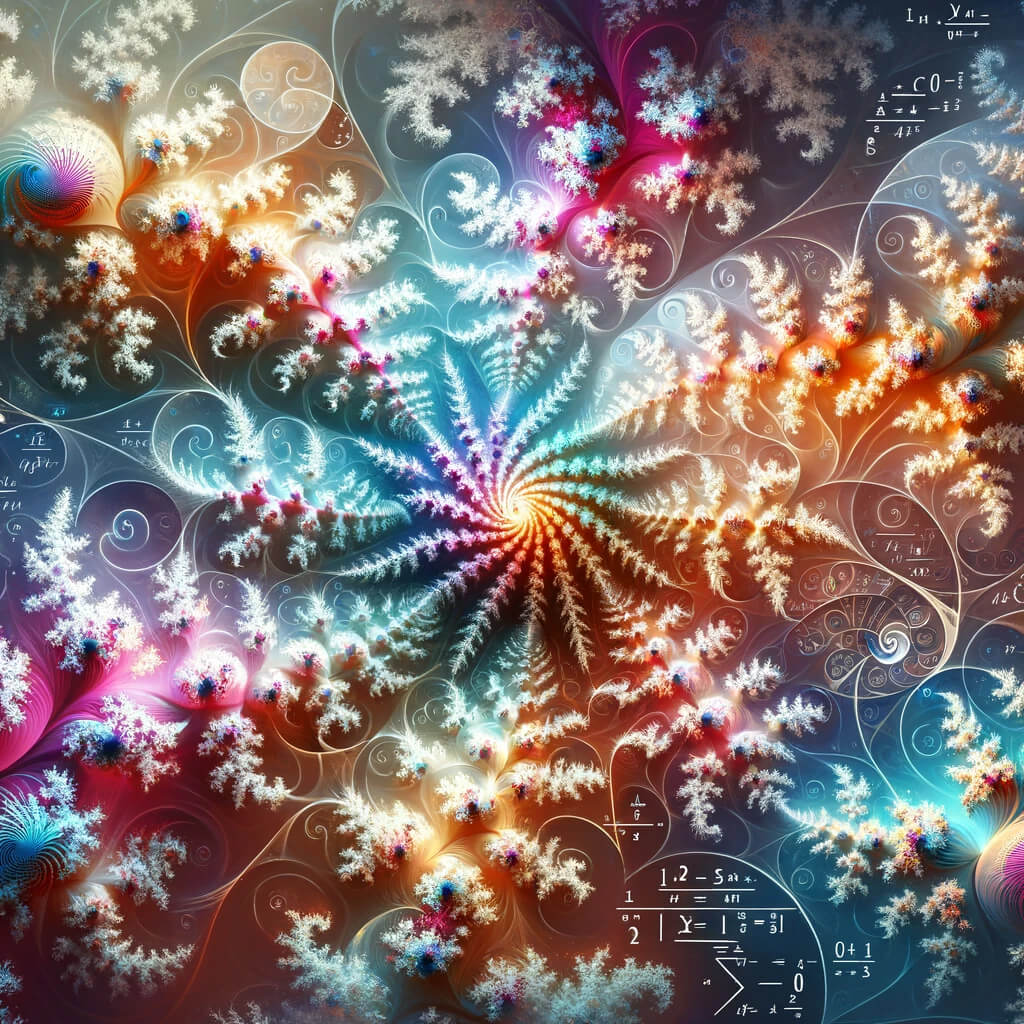Fractal Geometry: Comprehensive Guide + 5 Examples!
Dive into the fascinating world of fractal geometry with our latest blog post, where we unravel the intricate beauty and complex patterns that challenge traditional geometrical understanding.
Discover how fractals bridge the gap between mathematical theory and the mesmerizing patterns found in nature, art, and beyond.
Whether you’re captivated by the self-similar designs of coastlines and galaxies or intrigued by their applications in various scientific disciplines, this post will provide you with a comprehensive introduction to the infinite complexity and practical utility of fractal geometry.
Table of Contents
What is fractal geometry?
Fractal geometry is a branch of mathematics that studies complex shapes and patterns that are characterized by their self-similarity across different scales. This means that fractals look similar at various levels of magnification or resolution.
Unlike traditional geometry, which deals with shapes like circles, squares, and triangles, fractal geometry explores shapes that can have infinite detail, often appearing irregular and fragmented.
The concept of fractals extends beyond mere geometric patterns; it is a fundamental principle observed in nature, art, and many fields of science and engineering.
Fractals are used to model structures in the natural world that do not conform to simple geometric shapes, such as coastlines, mountains, clouds, tree branches, and even the distribution of galaxies.
Fractal geometry was popularized by the mathematician Benoît Mandelbrot in the 1970s, who showed how fractals can describe many complex and chaotic phenomena.
One of the most famous examples of a fractal is the Mandelbrot set, a set of points in the complex plane that forms an intricate, infinitely detailed border.
Key properties of fractals include:
- Self-similarity: Parts of the fractal are similar to the whole, often in a recursive or iterative process. This can be exact self-similarity, approximate self-similarity, or statistical self-similarity.
- Infinite complexity: Fractals can reveal more and more details as one zoom in, with no limit to the level of detail observed.
- Fractional dimension: Fractals can have dimensions that are not whole numbers, reflecting their complex structure that fills space differently than simple geometric shapes. The concept of fractional dimensions helps quantify the complexity and scaling behavior of fractals.
Fractal geometry has applications across many disciplines, including computer graphics, where it is used to create complex, natural-looking textures and landscapes; meteorology, for modeling weather patterns; medicine, in analyzing patterns of disease spread or physiological structures; and even in financial markets, to model price movements and market trends.
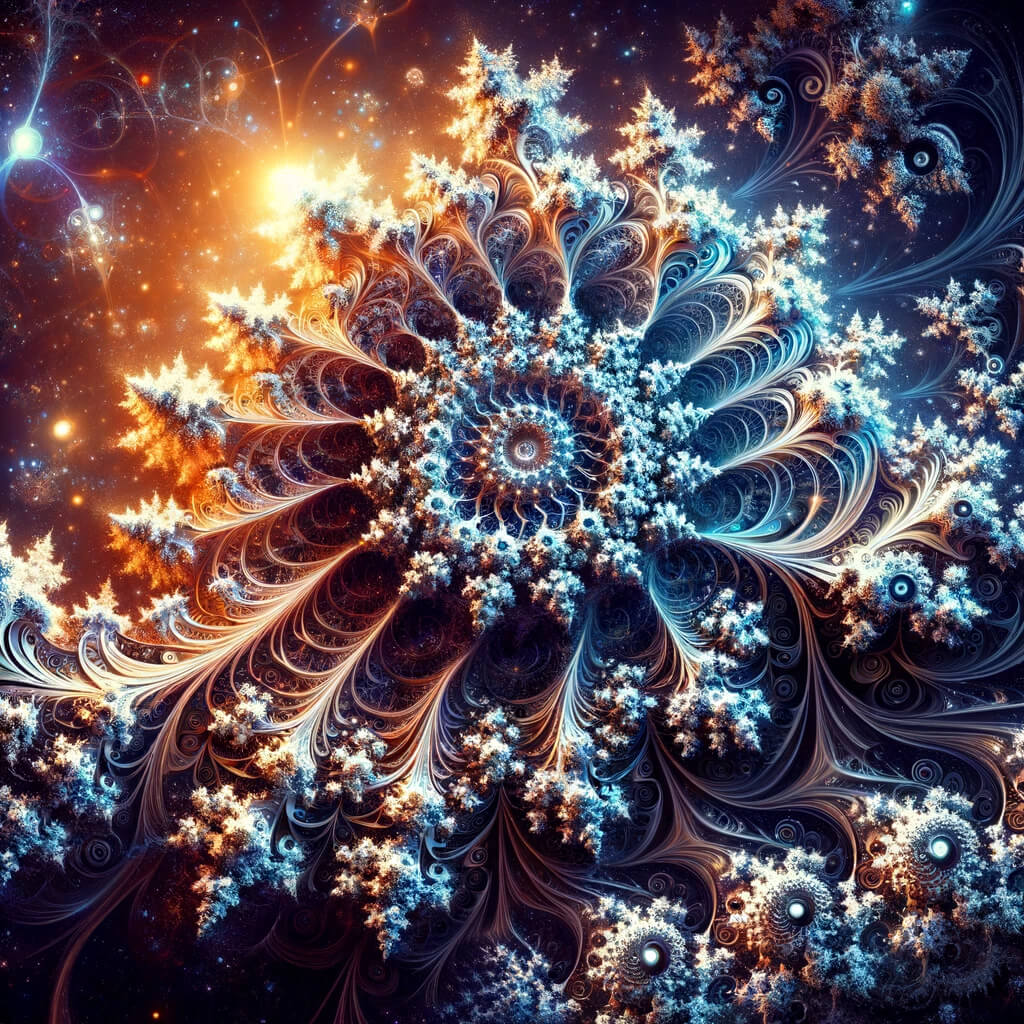
Examples of fractal geometry
Fractal geometry appears in both natural and human-made structures, illustrating the widespread application and beauty of fractals. Here are several examples:
1. Natural Examples:
- Coastlines and Rivers: The coastline paradox, introduced by Mandelbrot, describes how the measured length of a coastline depends on the scale of measurement, demonstrating fractal properties. Rivers and their tributaries often exhibit a fractal-like branching pattern.
- Trees and Plants: The branching patterns of trees and plants, where smaller branches mirror the structure of the whole tree, are examples of self-similarity. Ferns, with their repeating patterns at different scales, are another example.
- Mountains and Landscapes: Mountain ranges and certain landscapes show fractal-like structures, with self-similar patterns repeating at different scales, contributing to their rugged and intricate appearances.
- Clouds and Atmospheric Phenomena: The structure of clouds and the distribution of certain atmospheric phenomena can exhibit fractal-like patterns, reflecting the complex processes that shape weather and climate.
2. Biological Examples:
- Blood Vessels and Bronchial Trees: The branching patterns of blood vessels and the bronchial trees in the lungs are fractal-like, optimizing the flow of blood and air throughout the body.
- DNA and Cellular Structures: Certain molecular and cellular structures, including the folding patterns of DNA, have been described using fractal geometry to understand their complex, space-filling properties.
3. Geological Examples:
- Crystal Growth: Certain minerals and crystals grow in patterns that can be modeled using fractal geometry, reflecting the underlying physical and chemical processes.
- River Networks: The branching network of rivers and streams within a drainage basin often exhibits fractal characteristics, with patterns repeating at different scales.
4. Astronomical Examples:
- Galaxy Distribution: The large-scale structure of the universe, including the distribution of galaxies and galaxy clusters, has been described as fractal-like, with patterns repeating over vast distances.
5. Human-Made Examples:
- Art and Architecture: Artists and architects have used fractal principles to create visually appealing and structurally sound works. The recursive patterns in Islamic art and architecture, and the use of fractal geometry in modern designs, are examples.
- Computer Graphics: Fractal algorithms are used to generate complex, natural-looking landscapes, clouds, and textures in computer graphics and animations.
- Antennas: Certain types of antennas, designed with fractal shapes, are used to receive a wide range of frequencies due to their unique properties.
These examples demonstrate how fractal geometry serves as a bridge between mathematical theory and the complex patterns observed in the natural world, as well as its utility in various applications ranging from art to engineering.
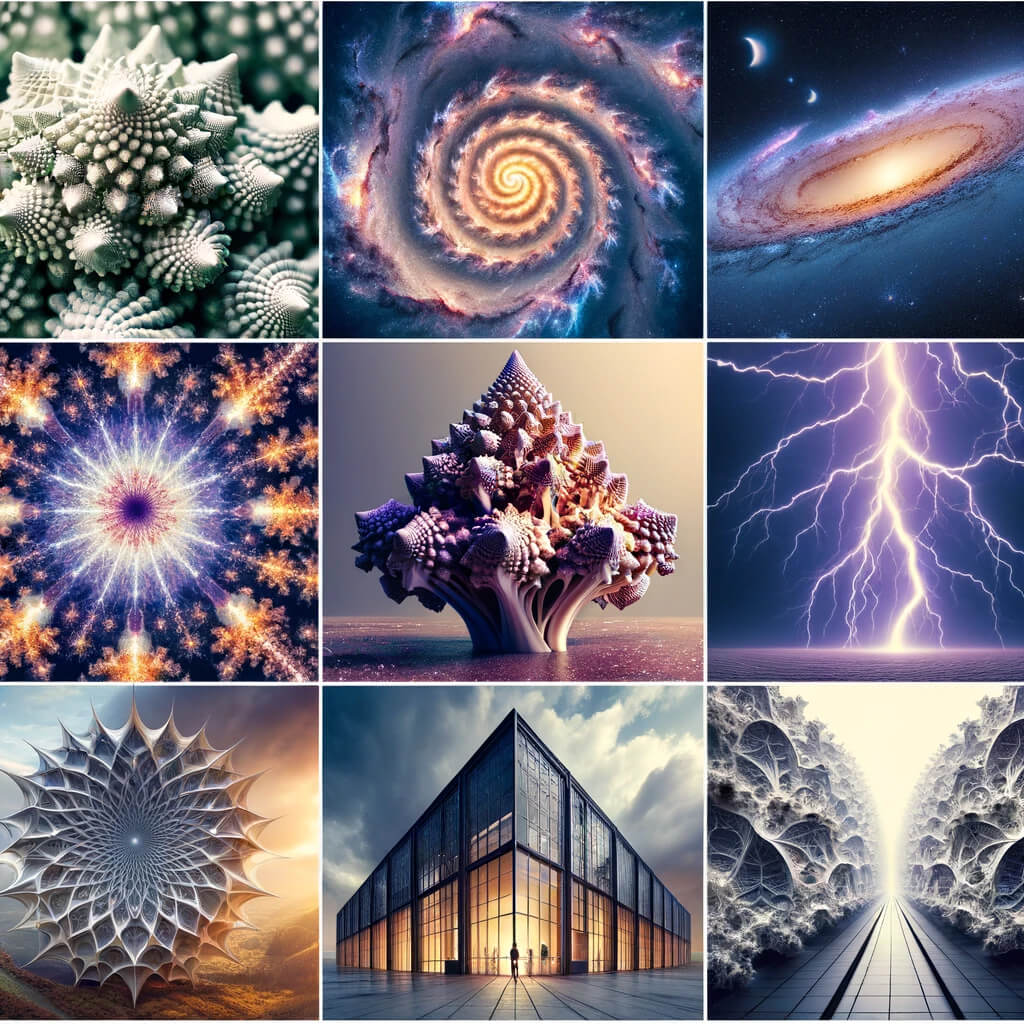
Who discovered fractal geometry?
Fractal geometry was popularized and given its name by the Polish-French mathematician Benoît Mandelbrot in the 1970s.
Mandelbrot’s work was groundbreaking because it provided a new framework for understanding the complex, irregular patterns observed in nature, which did not fit neatly into traditional Euclidean geometry.
His 1982 book, “The Fractal Geometry of Nature,” argued that many natural structures could be described as fractals, which are characterized by self-similarity across different scales.
While Mandelbrot is credited with the discovery and development of fractal geometry as a formal mathematical field, the concepts and observations that led to the development of fractals have a longer history.
For instance, in the 19th century, mathematicians like Karl Weierstrass and Georg Cantor developed functions and sets with unusual properties, such as continuous but nowhere differentiable functions, which hinted at the complexity of fractal-like shapes.
Additionally, the British mathematician Lewis Fry Richardson in the early 20th century worked on problems related to coastlines’ lengths, which later influenced Mandelbrot’s work on fractals.
Mandelbrot’s contribution was not only in recognizing these patterns across different branches of science but also in formalizing the concept of fractal geometry and demonstrating its applicability in modeling complex, real-world phenomena.
His work has led to significant advancements in various fields, including physics, biology, geology, and finance, by applying fractal theory to understand complex systems and patterns.

Do fractals have infinite perimeters?
Fractals can indeed have what is described as infinite perimeters, depending on how one defines and measures the perimeter within the context of fractal geometry.
This property is one of the most intriguing aspects of fractals, particularly when considering shapes like the Mandelbrot set or the coastline of Britain, which Benoît Mandelbrot himself famously discussed.
The concept of an infinite perimeter in fractals arises from their self-similar, infinitely detailed nature. As you measure the boundary of a fractal with increasingly smaller units (or scales), you find more details and intricacies, leading to an increase in the measured length of the perimeter.
This process can theoretically go on indefinitely as the scale of measurement becomes infinitesimally small, suggesting that the perimeter is infinitely long.
A classic example illustrating this concept is the coastline paradox, which describes how the measured length of a coastline depends on the length of the measuring stick used.
With a longer stick, the coastline’s length is shorter because small variations in the coastline’s shape are skipped over.
As the measuring stick gets shorter, allowing for the measurement of finer details, the calculated length increases. In the limit of an infinitesimally small measuring stick, the length of the coastline can grow without bound, suggesting an “infinite” length.
However, it’s important to note that this notion of infinity is conceptual and highlights the difference between fractal geometry and traditional Euclidean geometry, where objects have well-defined, finite perimeters.
The idea of an infinite perimeter challenges our understanding of geometry and measurement, demonstrating the unique and fascinating properties of fractals.
In practical terms, when dealing with real-world fractals like coastlines, the concept of an infinite perimeter is a mathematical abstraction, as physical constraints limit the level of detail that can exist or be measured.
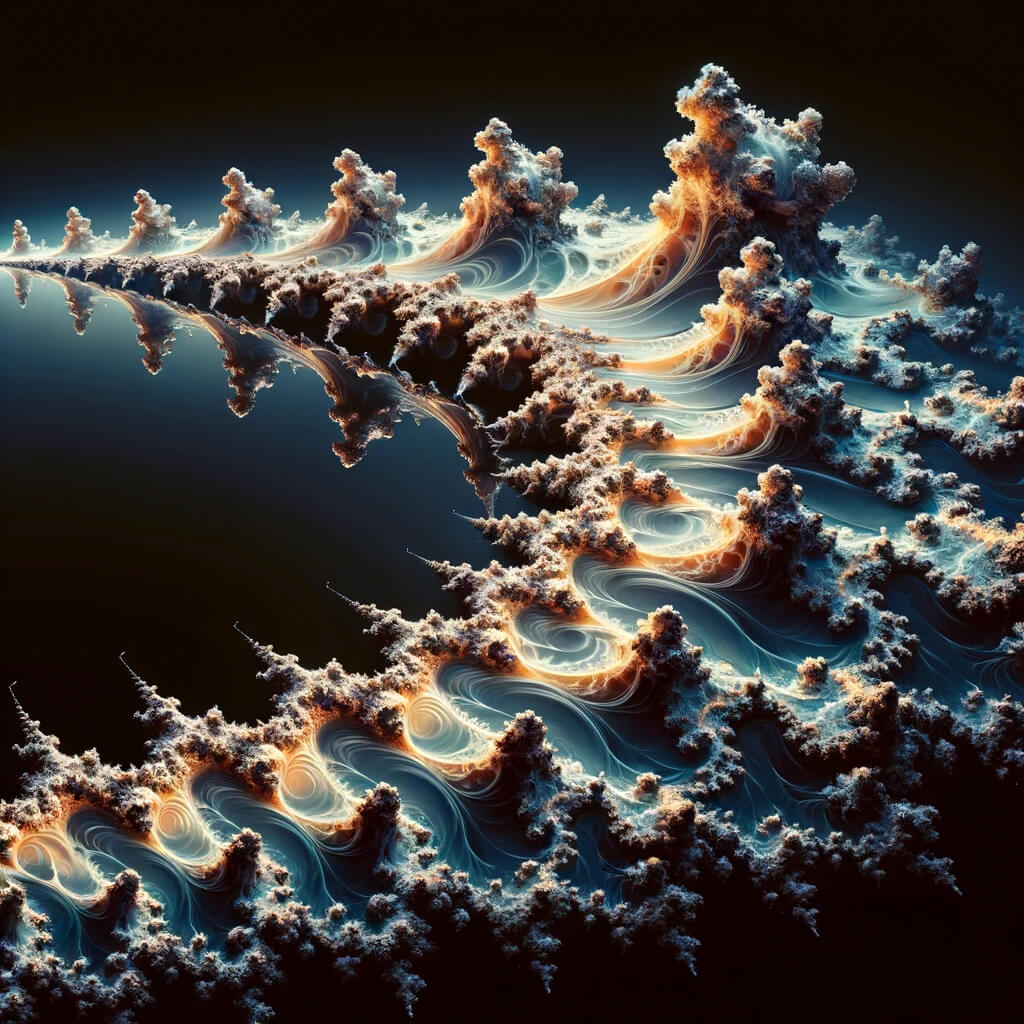
What are some applications of fractal geometry?
Fractal geometry finds applications across a wide range of fields, leveraging its unique properties to model complex systems and patterns that cannot be easily described using traditional geometric methods. Here are some notable applications:
- Computer Graphics and Animation: Fractals are used to create realistic landscapes, clouds, plants, and textures in computer graphics and video games. The self-similar nature of fractals allows for detailed and natural-looking scenes with relatively simple mathematical models.
- Telecommunications: Fractal antennas, which use self-similar designs, are compact and efficient across multiple frequency bands. This makes them ideal for mobile phones and other wireless communication devices.
- Medicine and Biology: Fractal analysis helps in understanding the complex structures of biological organisms, from the branching patterns of blood vessels and bronchi to the structure of tissues and tumors. This has applications in diagnostics, image analysis, and understanding the growth patterns of various diseases, including cancer.
- Geology and Geography: The fractal nature of landscapes, coastlines, and river networks is used in modeling and analyzing geographical formations and processes. This can help in predicting erosion, understanding the formation of river networks, and simulating landscapes in environmental research.
- Meteorology and Climatology: The fractal structure of clouds and weather systems aids in modeling and predicting weather patterns and climate dynamics. Fractal models can help simulate the complex processes that drive weather, improving forecast accuracy.
- Physics: Fractals are used in the study of chaos theory, turbulence, and the dynamics of complex systems. This includes modeling the distribution of galaxies in the universe and understanding the structure of materials at the nanoscale.
- Economics and Finance: The fractal market hypothesis uses fractal geometry to model and analyze financial markets’ movements and trends. This approach recognizes the chaotic and complex nature of market behavior, offering insights into asset price movements.
- Art and Architecture: Fractals influence design and art, where they are used to create visually appealing and often nature-inspired patterns and structures. The self-similar patterns of fractals can be seen in artworks, architectural designs, and decorations, reflecting natural aesthetics.
- Ecology and Environmental Science: Fractal geometry is applied in the study of ecosystems to understand the spatial distribution and density of vegetation, animal movements, and landscape patterns. This helps in conservation efforts and understanding the impact of human activities on natural habitats.
- Signal and Image Processing: Fractal compression is a method for compressing images using fractal algorithms, reducing file size while maintaining visual quality. This technique exploits the self-similarity in images to efficiently encode image data.
These applications highlight the versatility and broad impact of fractal geometry, demonstrating its ability to bridge the gap between abstract mathematical concepts and practical solutions in diverse scientific and technological fields.
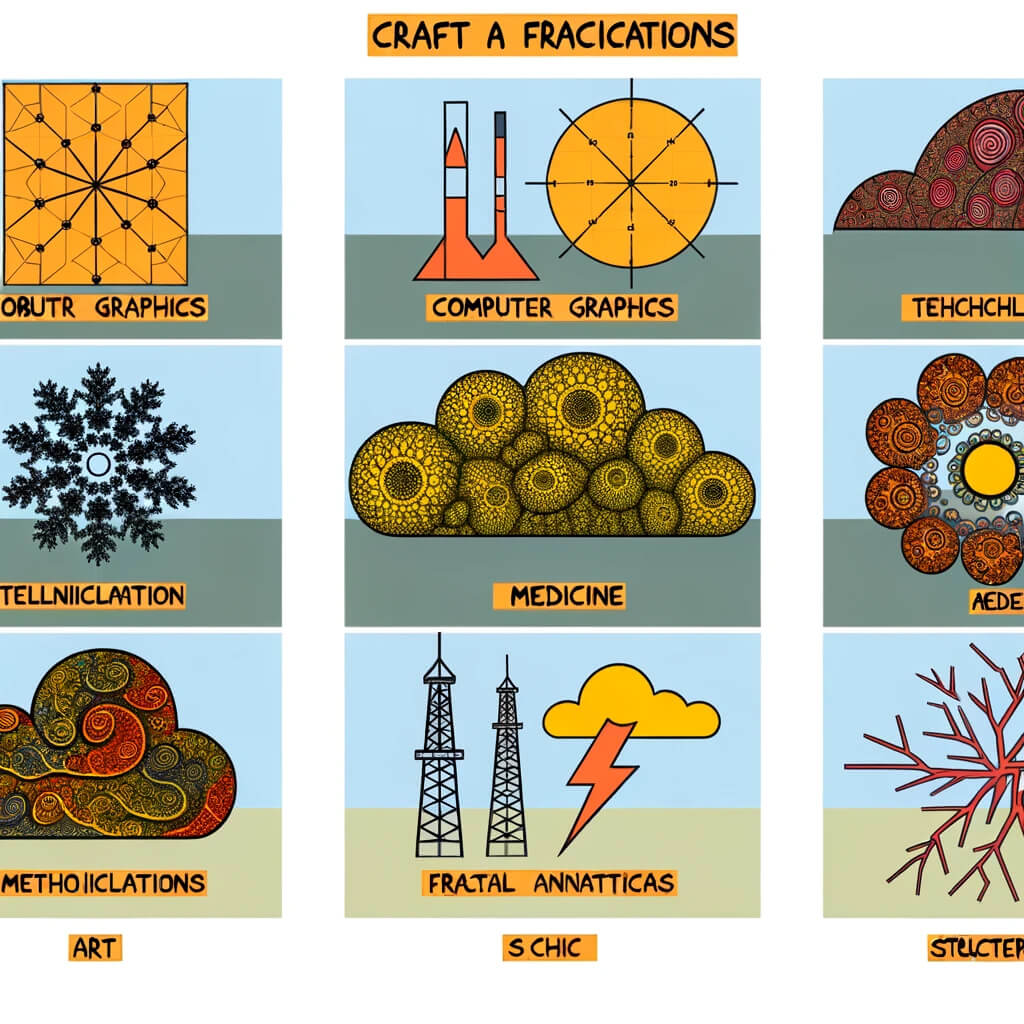
Chaos theory and fractal geometry
Chaos theory and fractal geometry are closely related concepts in mathematics and physics that deal with complex, dynamic systems.
While they focus on different aspects of these systems, their interrelation stems from the underlying patterns and structures that emerge from chaotic behavior and non-linear dynamics.
Chaos Theory
Chaos theory studies the behavior of dynamical systems that are highly sensitive to initial conditions, a phenomenon popularly referred to as the “butterfly effect.”
This sensitivity means that small differences in the initial state of the system can lead to vastly different outcomes, making long-term prediction practically impossible for some systems.
Chaos is found in various natural systems, such as weather patterns, the dynamics of satellites in the solar system, and the behavior of financial markets.
Key characteristics of chaotic systems include:
- Sensitivity to Initial Conditions: Tiny variations in the starting point of a system can lead to dramatically different outcomes.
- Non-linearity: Chaotic systems often involve non-linear relationships, where outputs are not directly proportional to inputs.
- Deterministic: Despite their unpredictable behavior, chaotic systems are deterministic, meaning their future dynamics are fully determined by their initial conditions, with no randomness involved.
Fractal Geometry
Fractal geometry, on the other hand, is concerned with complex geometric shapes exhibiting self-similarity across different scales. Fractals are used to describe and model phenomena in nature and mathematics that do not fit neatly into traditional Euclidean geometry.
The intricate patterns of fractals can be found in natural objects like coastlines, clouds, and plants, as well as in human-made systems and concepts.
Fractals share several connections with chaos theory:
- Self-Similarity and Scale Invariance: Many chaotic systems exhibit fractal structures in their space or time dynamics. The state space of a chaotic system, where all possible states of the system are represented, often contains fractal structures known as strange attractors.
- Complexity from Simple Rules: Both fractals and chaotic systems can arise from relatively simple mathematical equations undergoing iterative processes. This simplicity underlying complex behavior highlights a key insight of both fields.
- Emergence: The complexity and often unpredictability of both fractals and chaotic systems arise from the interaction of simple components or rules, leading to emergent behavior that is not easily deduced from the parts alone.
Interconnection
The interconnection between chaos theory and fractal geometry lies in their mutual emphasis on complexity, patterns, and scaling properties in natural and abstract systems. For instance, the Lorenz attractor, a classic example of a chaotic system, displays fractal dimensions and structure.
Similarly, the Mandelbrot set, a famous fractal, can be seen as the boundary between stable and chaotic dynamics in a particular mathematical iteration.
In summary, while chaos theory and fractal geometry focus on different aspects of complex systems—temporal dynamics and geometric patterns, respectively—they overlap in their study of the unpredictable and intricate patterns that emerge from simple laws of nature.
This synergy has enriched our understanding of the natural world and influenced various fields, from physics and biology to economics and art.

Fractal geometry equation
Fractal geometry encompasses a variety of equations and algorithms used to generate or describe fractals. Among the most famous and foundational to the field is the equation underlying the Mandelbrot set. This set is defined by a simple iterative equation related to complex numbers.
The beauty of the Mandelbrot set lies in its complex and infinitely detailed boundary generated by such a straightforward iterative process.
The Mandelbrot Set Equation
The Mandelbrot set is created by iterating the equation:
zn+1 = zn2+ c
where:
- (c) is a complex number (representing a point in the complex plane),
- (z) is a complex variable,
- (z0 = 0) for all points (c),
- (n) is the iteration step.
The process involves applying the equation repeatedly, using the output of one iteration as the input for the next:
- Start with (z0 = 0).
- For a given point (c) in the complex plane, calculate (z1 = z02+c).
- Then, calculate (z2 = z12 + c), and so on.
- Repeat this process many times.
The point (c) is considered part of the Mandelbrot set if, after many iterations, the value of (z) remains bounded (does not go to infinity).
The beauty and complexity of the Mandelbrot set come from the boundary between points that escape to infinity and those that remain bounded, which exhibits an infinitely intricate fractal structure.
Visualization and Coloring
Although the basic criterion for membership in the Mandelbrot set is binary (either a point is in the set or not), visualizations often use color to represent how quickly values of (z) escape to infinity for points not in the set.
The rate of escape is used to assign colors, creating the beautiful and intricate patterns often associated with fractal images.
Generalization and Other Fractals
There are many other equations and systems used to generate different types of fractals, including:
- Julia sets, which are closely related to the Mandelbrot set but use a fixed complex number (c) for all points and vary the initial value of (z).
- Fractal trees, use recursive algorithms to simulate natural branching patterns.
- The Sierpinski triangle, is generated through a process of repeatedly subdividing a triangle into smaller triangles.
Each of these fractals relies on the repetition of simple rules or equations, demonstrating the incredible complexity that can arise from basic mathematical processes. The exploration of fractals continues to be a rich field of mathematical and scientific inquiry, revealing the underlying patterns that shape our world.

Conclusion
In exploring the captivating realm of fractal geometry, we’ve journeyed through its discovery, intricate patterns, and wide-ranging applications, from the arts to engineering.
This mathematical field not only enriches our understanding of the natural and digital worlds but also continues to inspire innovation and creativity across numerous disciplines.
As we conclude, it’s clear that fractal geometry serves as a powerful testament to the beauty and complexity inherent in the patterns of the universe, inviting us to look closer and discover the endless possibilities hidden within seemingly chaotic forms.
